Launch Window(Subject to change) | August 18, 2020 – 14:31 UTC | 10:31 EDT |
|---|---|
Mission Name | |
Launch Provider
| SpaceX |
Customer
| |
Rocket | Falcon 9 Block 5 B1049.6 |
Launch Location | Space Launch Complex 40 (SLC-40), Cape Canaveral Air Force Station, Florida |
Payload mass | 18,000 kg (~41,000 lbs) (58 x 260 kg, plus dispenser, plus 3 x 120 kg Sky Sat) |
Where are the satellites going? | 550 km Low-Earth Orbit (Initally 210 x 366 km) |
How’s the weather looking? | The weather is currently 80% go for launch (as of August 17th, 11:30 UTC) |
Will they be attempting to recover the first stage? | Yes |
Where will the first stage land? | 634 km downrange on Of Course I Still Love You |
Will they be attempting to recover the fairings? | Go Ms. Tree and Go Ms. Chief are dispatched and downrange. Catch attempt possible |
Are these fairings new? | No, the fairing last flew on Starlink L4 |
This will be the: |
|
Where to watch | SpaceX official stream Tim Dodd, the Everyday Astronaut, will be streaming at T-30 minutes; come ask questions and join the conversation live! |
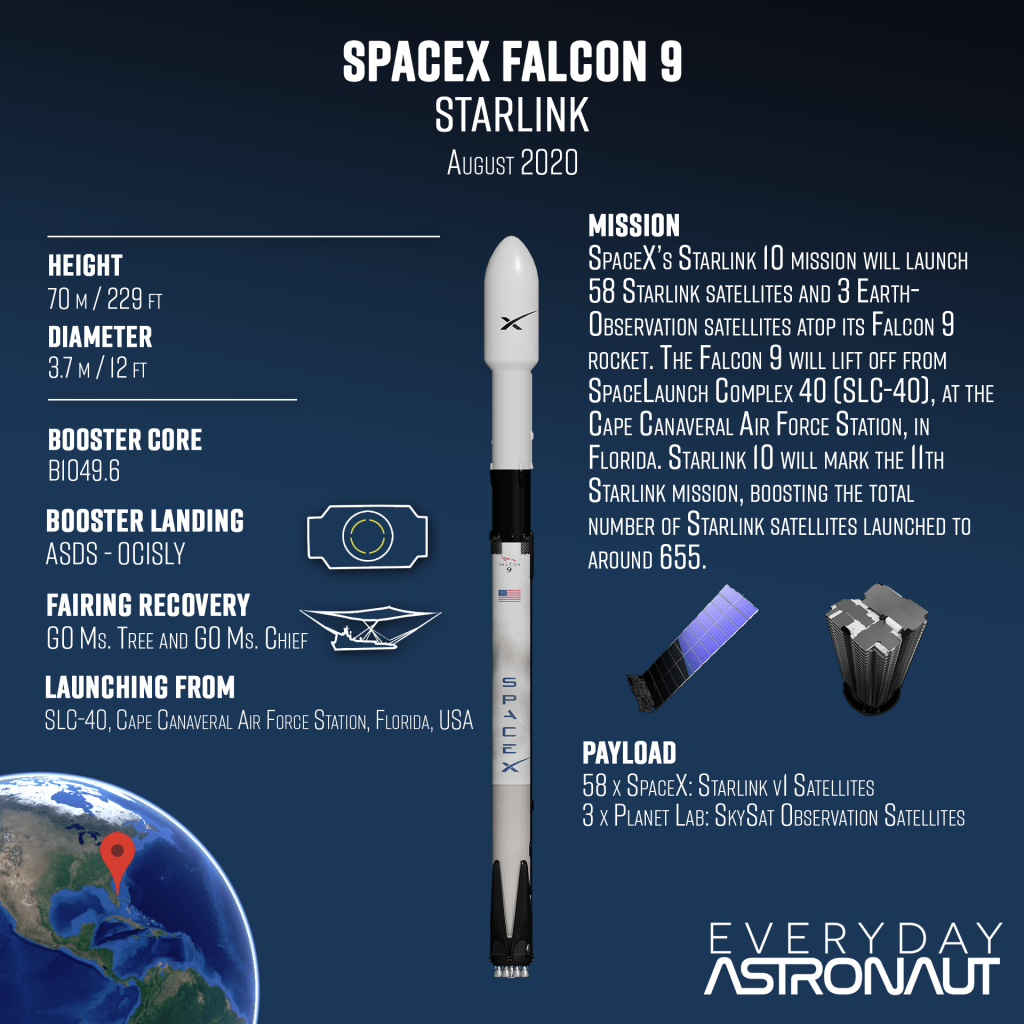
What’s this all mean?
SpaceX’s Starlink 10 mission will launch 58 Starlink satellites and 3 Earth-Observation satellites atop its Falcon 9 rocket. The Falcon 9 will lift off from Space Launch Complex 40 (SLC-40), at the Cape Canaveral Air Force Station, in Florida. Starlink 10 will mark the 11th Starlink mission, boosting the total number of Starlink satellites launched to around 655.
What is Starlink?
Starlink is SpaceX’s internet communication satellite constellation. The Low-Earth orbit constellation will deliver fast, low-latency internet service to locations where ground-based internet is unreliable, unavailable, or expensive.
Starlink is currently in an employee beta, but a public beta is expected to start in under 6 months. As of now, only higher latitudes are covered. However, SpaceX only needs 24 launches for global coverage. Given SpaceX’s current Starlink production and launch rate, Starlink will have global coverage by the middle of 2021.
Once Starlink is complete, its venture is expected to profit $30-50 billion annually. This profit will largely finance SpaceX’s ambition Starship and program, as well as Mars Base Alpha.

What is the Starlink Satellite?
Each Starlink V1.0 satellite has a compact design, and a mass of 260 kg. SpaceX developed a flat-panel design, allowing them to fit as many satellites as possible into the Falcon 9’s 5.2-meter wide payload fairing. Due to this flat design, SpaceX is able to fit up to 60 Starlink satellites and the payload dispenser into the second stage, while still being able to recover the first stage. This is near the recoverable Falcon 9’s payload capacity to LEO, at around 16 tonnes.
For how small each Starlink satellite is, each one is packed with high-tech communication and cost-saving technology. Each Starlink satellite is equipped with 4 phased array antennas, for high bandwidth and low-latency communication, and two parabolic antennas. The satellites also include a star tracker, which provides the satellite with attitude data, ensuring precision in broadband communication.
The Starlink satellites are also equipped with an autonomous collision avoidance system, which utilizes the DOD’s debris tracking database to autonomously avoid collisions with spacecraft and space junk.
To decrease costs, each satellite only has a singular solar panel, which simplifies the manufacturing process and cuts costs. To further cut costs, Starlink’s propulsion system, an ion thruster, uses Krypton as a fuel, instead of Xenon. While the ISP of Krypton is significantly lower than Xenon’s, it is far cheaper, which further decreases the satellite’s manufacturing cost.
Ion Power
Each Starlink satellite is equipped with the first Hall-effect Krypton powered ion thruster. This thruster is used both for ensuring the correct orbital position, but is also used for orbit raising and orbit lowering. At the end of the satellite’s life, this thruster is used to deorbit the satellite.
What is the Starlink Satellite Constellation?
A satellite constellation is a group of satellites that work in conjunction for a common purpose. Currently, SpaceX plans to form a network of roughly 12,000 satellites; however, in 2019 SpaceX filed an application with the Federal Communication Commission (FCC) for permission to launch and operate an additional 30,000 satellites. These additional satellites would be placed in orbits ranging from 328 km to 580 km, which would further decrease latency, and increase the bandwidth. To put this number of satellites into perspective, this is roughly 20 times more satellites than were launched before 2019.
Of the initial 12,000 satellites, 4,400 would operate on the Ku and Ka bands, with the rest operating on the V-Band.
To achieve initial coverage, SpaceX will use 72 orbital planes, in a 53 degree 550 km circular orbit. The Starlink constellation will then communicate with other Starlink satellites and ground stations, to form a mesh network.
Due to the vast number of Starlink satellites, many astronomers are concerned about their effect on the night sky. However, SpaceX is working with the astronomy community and implementing changes to the satellites to make them harder to see from the ground and less obtrusive to the night sky. SpaceX has changed how the satellites raise their orbits and, starting on Starlink V1.0 L9, added a sunshade to reduce light reflectivity. These changes have already significantly decreased the effect of Starlink on the night sky.
What is a Skysat satellite?
The SkySat Constellation is a constellation of Earth observation satellites built and operated by Planet Labs. There are currently 18 SkySats in a 500 km SSO. Each satellite is about an 80 cm large cube, with a mass of 120 kg. The camera on each satellite has a resolution of less than a meter. The SkySat constellation is used to monitor the movement of goods and people, allowing for data to be gained and used to optimize supply chains, shipping, plant activity, and humanitarian relief efforts.

What is Falcon 9 Block 5?
The Falcon 9 Block 5 is SpaceX’s partially reusable two-stage medium-lift launch vehicle. Block 5 is the final iteration of the Falcon 9; the goal is to apply all the lessons learned from 56 previous Falcon 9 flights into a human-rated reusable rocket. The Falcon 9 contains 3 main components: a reusable first stage, an expendable second stage, and a reusable fairing.
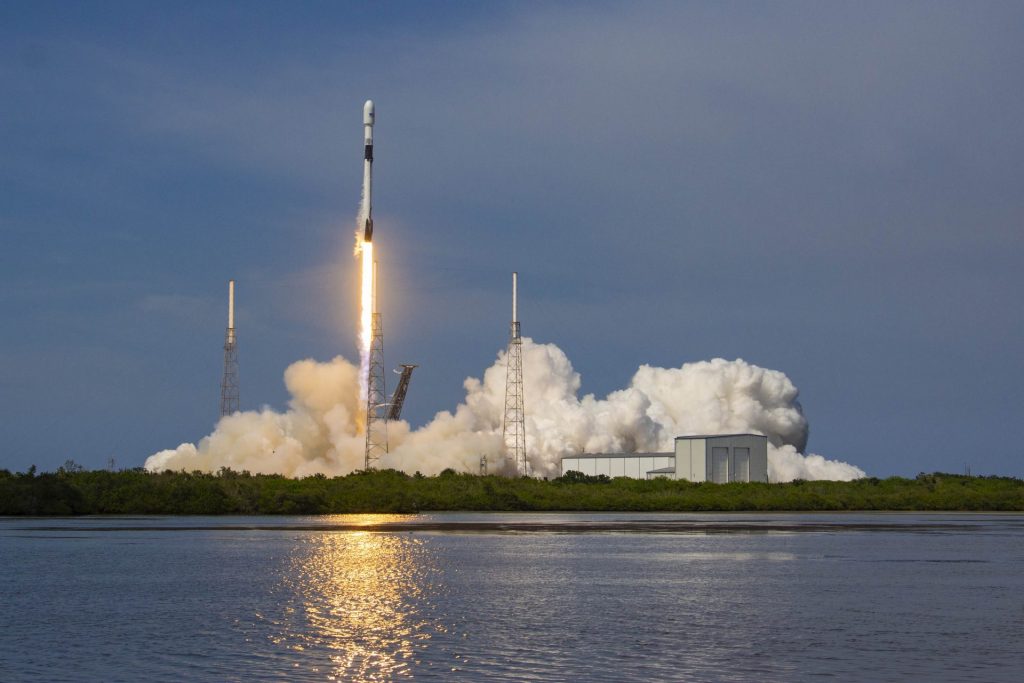
Block 5 updates:
SpaceX introduced a lot of changes on Block 5, allowing it to become the crewed-launching reusable rocket that we know today. To start, the Composite Overwrapped Pressure Vessel (COPV) had to undergo a complete redesign. NASA mandated the COPV redesign, as it had been the cause of both of the Falcon 9 failures: AMOS-6 and CRS-7.
Alongside with certification for human spaceflight, Block 5 came with a number of other major changes. To increase the amount of flight each booster could handle, and decrease the turnaround time, SpaceX reinforced the landing legs, upgraded the grid fins, and added a carbon fiber interstage. They also added heat resistant external paint and upgraded the engines. For more information about the changes in Block 5, and the other Blocks of the Falcon 9, check out this video by the Everyday Astronaut:
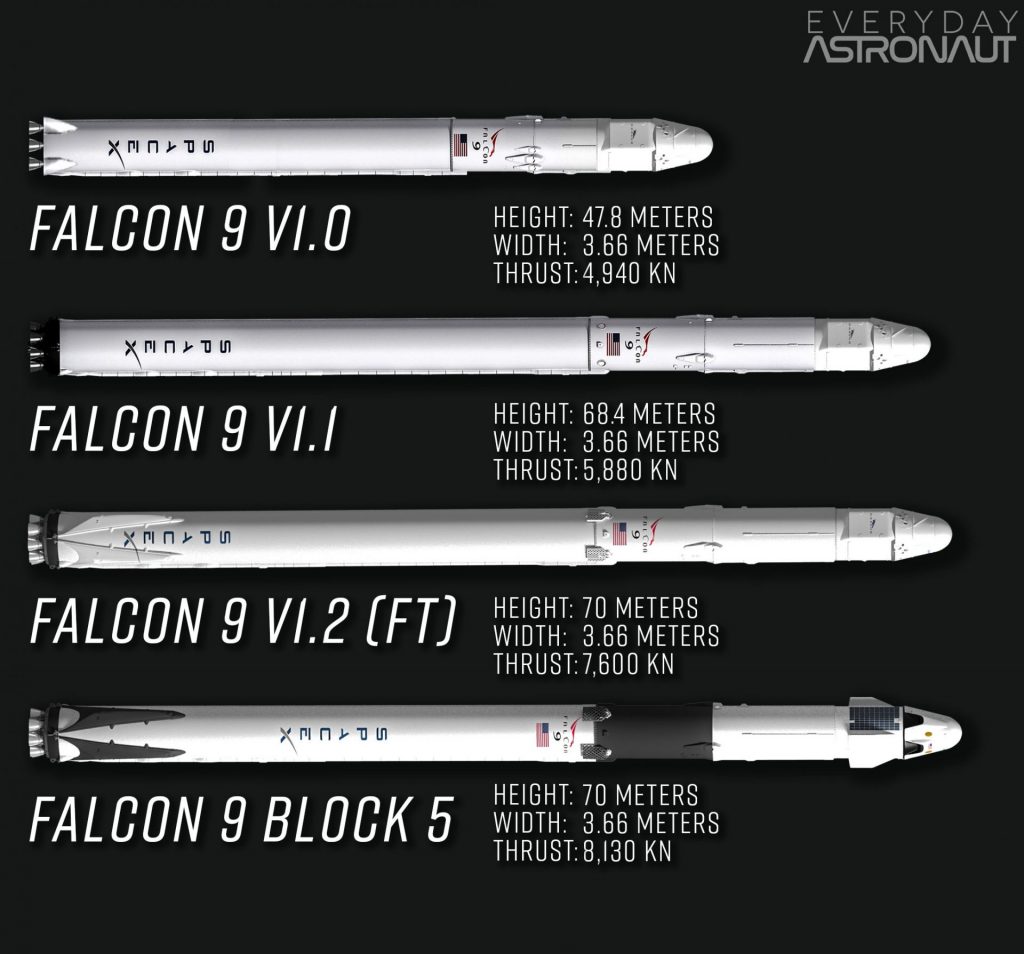
Falcon 9 Booster B1049
The booster supporting this mission is B1049; it was the fourth Falcon 9 Block 5 built. It first flew on Telstar 18V/Apstar-5C on September 10, 2018. This booster’s second flight was on the Iridium NEXT-8 mission, on January 11, 2019; the third mission of the booster was the one, and only, Starlink V0.9 launch on 5/24/18. The boosters fourth mission was on the second operational Starlink launch, on January 7, 2020, and its last flight, its fifth flight, was on the seventh operational mission on 6/3/20. Starlink 10 will mark the first time a booster has flown for a 6th time. This changes the vehicle’s designation to B1049.6!
Following stage separation, the Falcon 9 will conduct 3 burns. These burns will softly touch down the booster on Of Course I Still Love You 634 KM downrange.
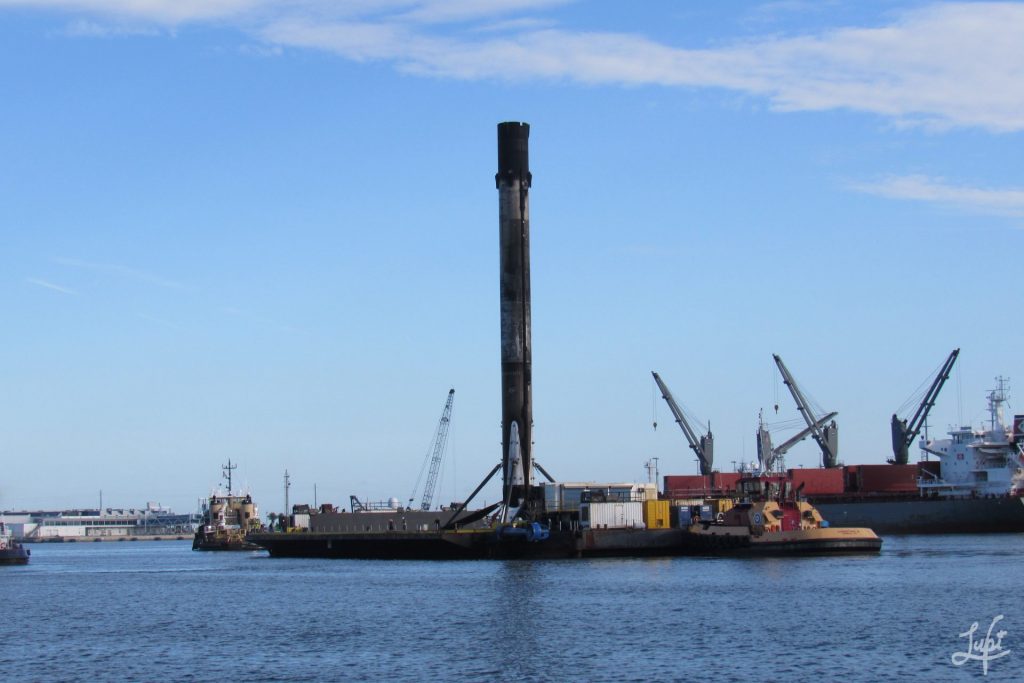
Fairing Reuse
SpaceX is the first entity ever that recovers and reflies its fairings. The recovery vessels, Go Ms. Tree and Go Ms. Chief, will most likely attempt to recover the fairing halves. After being jettisoned, the two fairing halves will use cold gas thrusters to orientate themselves as they descend through the atmosphere. Once at a lower altitude, they will deploy parafoils to help them glide down to a soft landing for recovery.

A fairing half being lifted off Go Ms. Tree (Credit: Lupi) 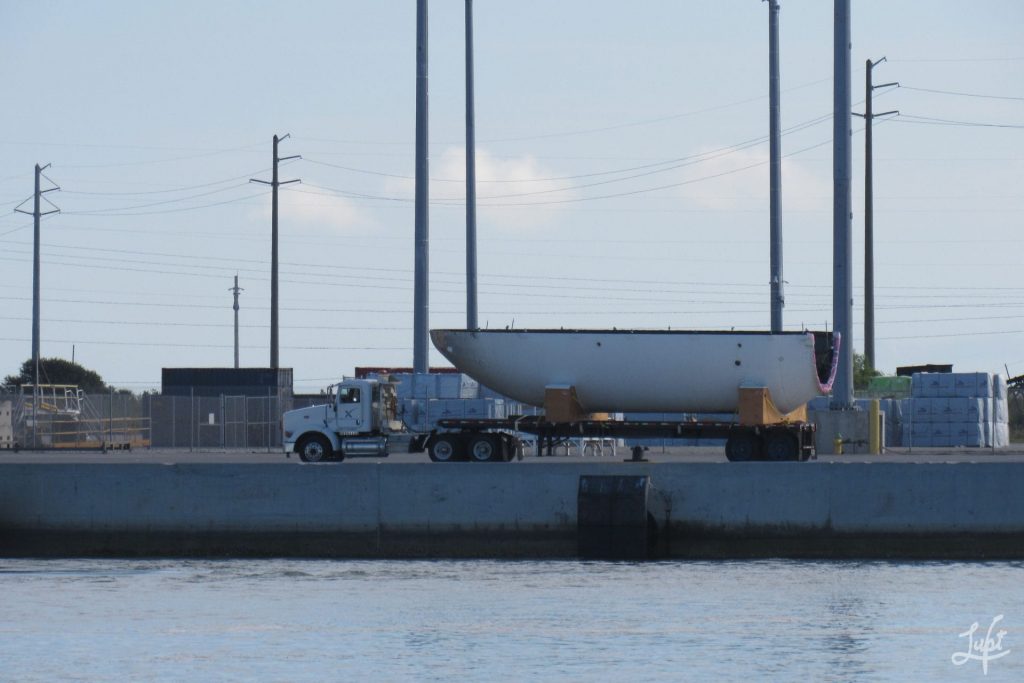
Fairing half loaded on semi (Credit: Lupi) 
Fairing Half being unloaded from Go Ms. Tree 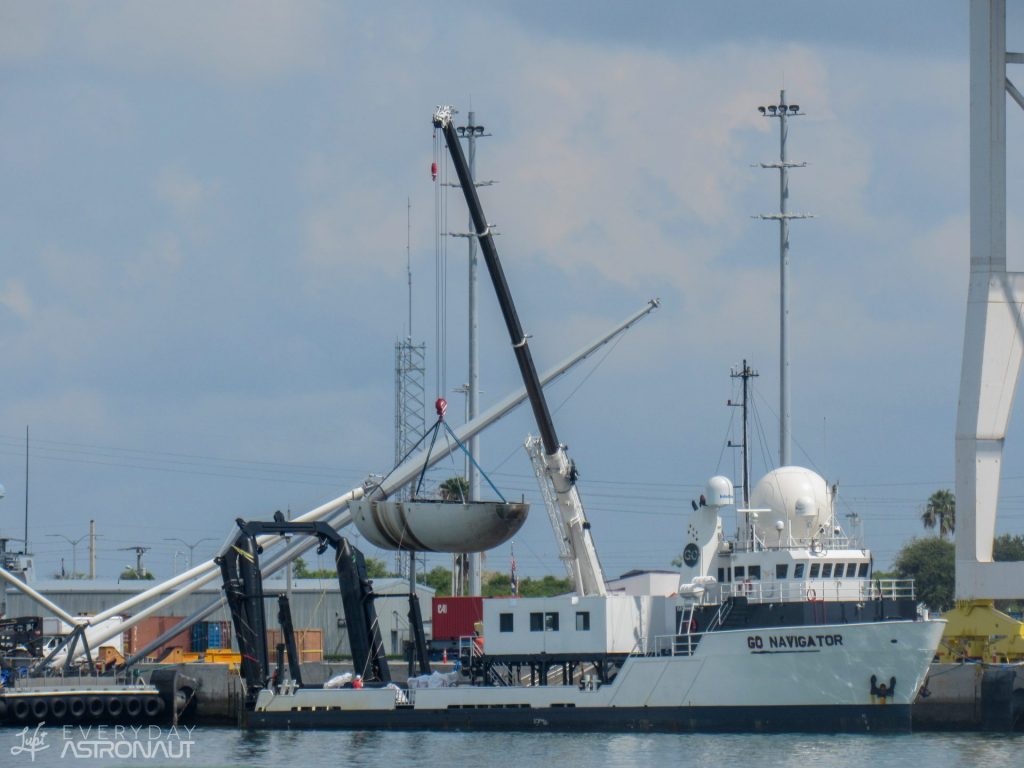
Half of the fairing being taken off Go. Navigator. (Credit: Lupi)
Starlink 10 Full Mission Profile
Hr/Min/Sec Event
– 00:38:00 SpaceX Launch Director verifies go for propellant load.
– 00:35:00 RP-1 (rocket grade kerosene) loading underway.
– 00:35:00 1st stage LOX (liquid oxygen) loading underway
– 00:16:00 2nd stage LOX loading underway
– 00:07:00 Falcon 9 begins engine chill prior to launch
– 00:01:00 Command flight computer to begin final prelaunch checks
– 00:01:00 Propellant tank pressurization to flight pressure begins
– 00:00:45 SpaceX Launch Director verifies go for launch
– 00:00:03 Engine controller commands engine ignition sequence to start
– 00:00:00 Falcon 9 Liftoff
Launch, Landing, and Satellite Deployment*
Hr/Min/Sec Event
00:01:12 Max Q (moment of peak mechanical stress on the rocket)
00:02:33 1st stage main engine cutoff (MECO)
00:02:36 1st and 2nd stages separate
00:02:43 2nd stage engine starts
00:03:12 Fairing deployment
00:07:02 1st stage entry burn complete
00:08:42 1st stage landing
00:08:51 2nd stage engine cutoff (SECO)
00:12:32 SkySat-21 deployment
00:13:02 SkySat-20 deployment
00:13:32 SkySat-19 deployment
00:45:57 Starlink 10 satellites deploy
* All times are approximate





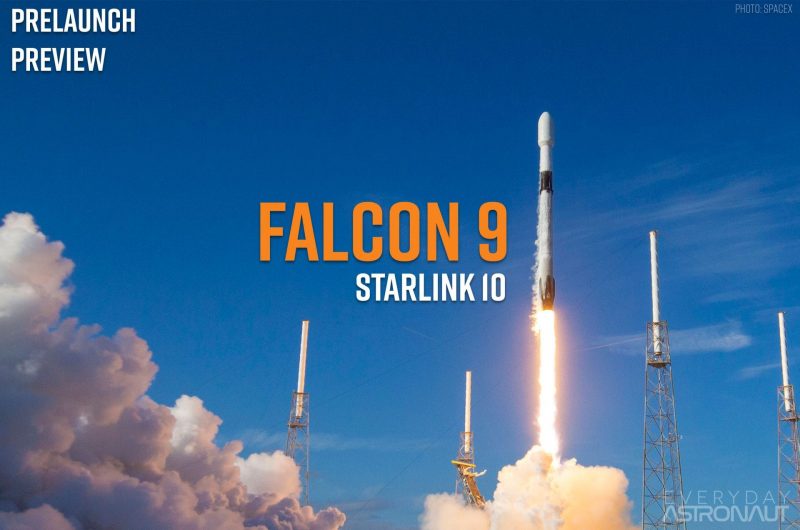
Thank for your efforts, thanks for sharing.
????
You could use an editor, but those of us who follow your exploits and value your explanations and honest and enthusiastic investigations probably don’t care much. I did have to back up and reread the passage quoted above and parse it myself.
KEEP UP THE EXCELLENT WORK.
You make everything understandable to people with some education ! Most sites are either trying to get 8 year olds excited about space by using lame sportscaster format, (Talking about you NASA!) or a horrible mix of stuff for 8 year olds and Post Doc level jargon and lame attempts to mimic SpaceX or JPL control room excitement!
You nail it, and the excitement is genuine like you are living an impossible excellent dream !
You are goofy but your presentations are so good I always recommend your coverage.
Live long and prosper!
Thank you for the excellent reporting. I really learn a lot of new things every day.
Quick, maybe unrelated, question: Was there ever plans for the second stage to be recoverable? Or was that thrown out as unfeasible, especially in the light of Starship development?
Thank you for your time and effort.
At one point, it was considered. Tim actually has a rundown on it at the following link: https://www.youtube.com/watch?v=4rC2Z5El-8E
That kind of went out the window when the plans for Starship (although technically still ITS at that point) solidified. There were also major technical challenges, but it could have feasibly been done.
Maybe this helps you! Or at least gives you context!
Thank for all u do to the space enthusiast community i have 1 suggestion tho can u say wat all mission did these reused boosters fly too in the prelaunch previews I get a little bogged down as these reuse numbers get highs and higher
Tim,
Recently I’ve been interested in knowing what the g forces are during the launches, but not interested enough to do the work. 🙂
I can step through the video, throw the speeds into a spreadsheet every x number of frames, and calculate the g force, but I’d like it much better if you’d do that, create a graph or a g-force meter, overlay it on a launch video, and then talk us through whatever interesting physics and factors that you want to talk about.
I’d watch that.
Thank you for being consistently professional, kind and amazingly humble.